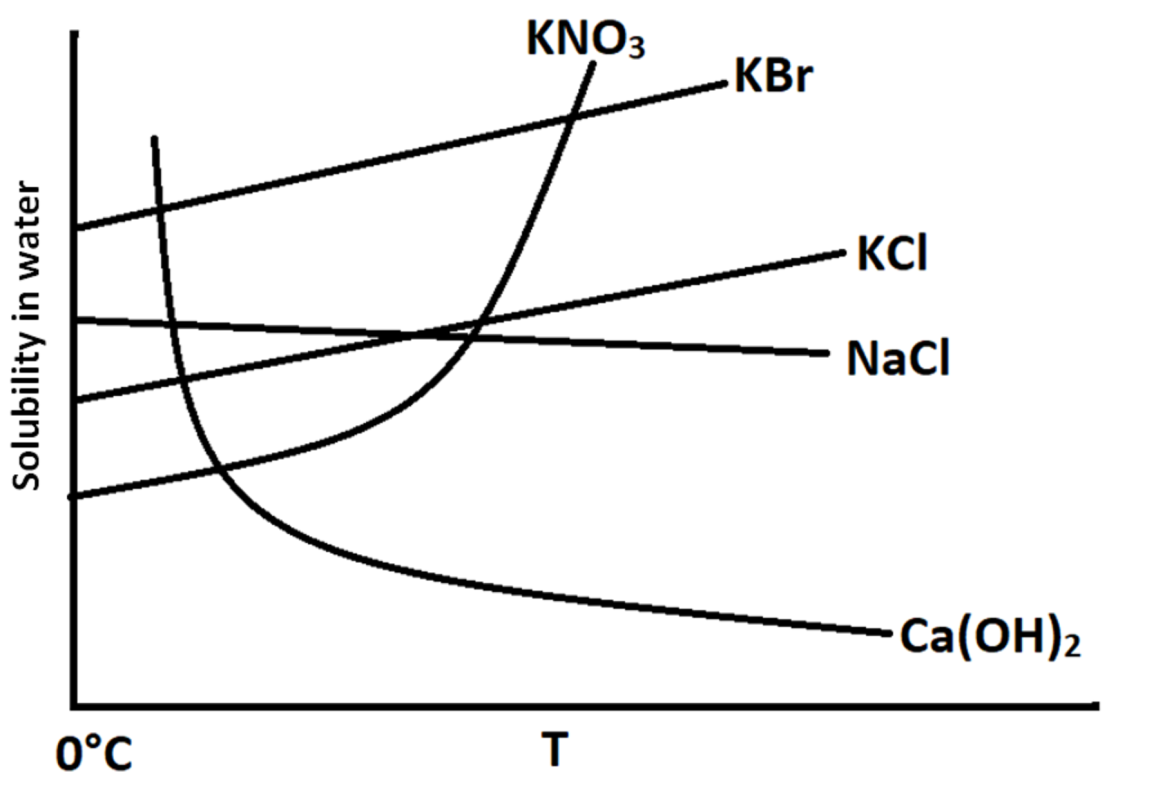
Which shows exothermic dissolution?

A.
B.
C.
D.

Answer
488.4k+ views
Hint: For dissolution to be exothermic, the solubility of a compound would decrease with increase in temperature.
Complete step by step answer:
Exothermic Reaction – A reaction in which there is evolution of heat is called an exothermic reaction.
Dissolution – The process of solubilisation of a solute into a solvent is called dissolution.
When a solute is dissolved in a liquid, there exists an equilibrium between the solid phase and the dissolved phase of the solute. A substance which shows exothermic dissolution shows more solubility at lower temperature and less solubility at high temperature. This occurs in accordance with the Le Chatelier's Principle. An increase in temperature of an exothermic reaction will decrease the rate of forward reaction.
So, for a substance to exhibit exothermic dissolution, its solubility should decrease with increase in temperature. From the graph, we can see that the solubilities are shown on y – axis and the temperature is shown on the x – axis.
It is shown in the graph that the solubility of
The solubility of
In case of
Hence, option D is correct.
Additional information:
Le Chatlier’s principle is also known as the Equilibrium Law. It states that when a system, which has been at equilibrium for a long period of time, is subjected to a change in temperature, concentration of reactants or products, volume or pressure, the equilibrium shifts in that direction in which the effect of change can be undone.
Note:
Any change in the equilibrium of a system is treated such that the impact of the change can be undone.
Complete step by step answer:
Exothermic Reaction – A reaction in which there is evolution of heat is called an exothermic reaction.
Dissolution – The process of solubilisation of a solute into a solvent is called dissolution.
When a solute is dissolved in a liquid, there exists an equilibrium between the solid phase and the dissolved phase of the solute. A substance which shows exothermic dissolution shows more solubility at lower temperature and less solubility at high temperature. This occurs in accordance with the Le Chatelier's Principle. An increase in temperature of an exothermic reaction will decrease the rate of forward reaction.
So, for a substance to exhibit exothermic dissolution, its solubility should decrease with increase in temperature. From the graph, we can see that the solubilities are shown on y – axis and the temperature is shown on the x – axis.
It is shown in the graph that the solubility of
The solubility of
In case of
Hence, option D is correct.
Additional information:
Le Chatlier’s principle is also known as the Equilibrium Law. It states that when a system, which has been at equilibrium for a long period of time, is subjected to a change in temperature, concentration of reactants or products, volume or pressure, the equilibrium shifts in that direction in which the effect of change can be undone.
Note:
Any change in the equilibrium of a system is treated such that the impact of the change can be undone.
Latest Vedantu courses for you
Grade 11 Science PCM | CBSE | SCHOOL | English
CBSE (2025-26)
School Full course for CBSE students
₹41,848 per year
Recently Updated Pages
Master Class 11 Economics: Engaging Questions & Answers for Success

Master Class 11 Business Studies: Engaging Questions & Answers for Success

Master Class 11 Accountancy: Engaging Questions & Answers for Success

Master Class 11 English: Engaging Questions & Answers for Success

Master Class 11 Computer Science: Engaging Questions & Answers for Success

Master Class 11 Maths: Engaging Questions & Answers for Success

Trending doubts
State and prove Bernoullis theorem class 11 physics CBSE

1 ton equals to A 100 kg B 1000 kg C 10 kg D 10000 class 11 physics CBSE

State the laws of reflection of light

One Metric ton is equal to kg A 10000 B 1000 C 100 class 11 physics CBSE

1 Quintal is equal to a 110 kg b 10 kg c 100kg d 1000 class 11 physics CBSE

Difference Between Prokaryotic Cells and Eukaryotic Cells




